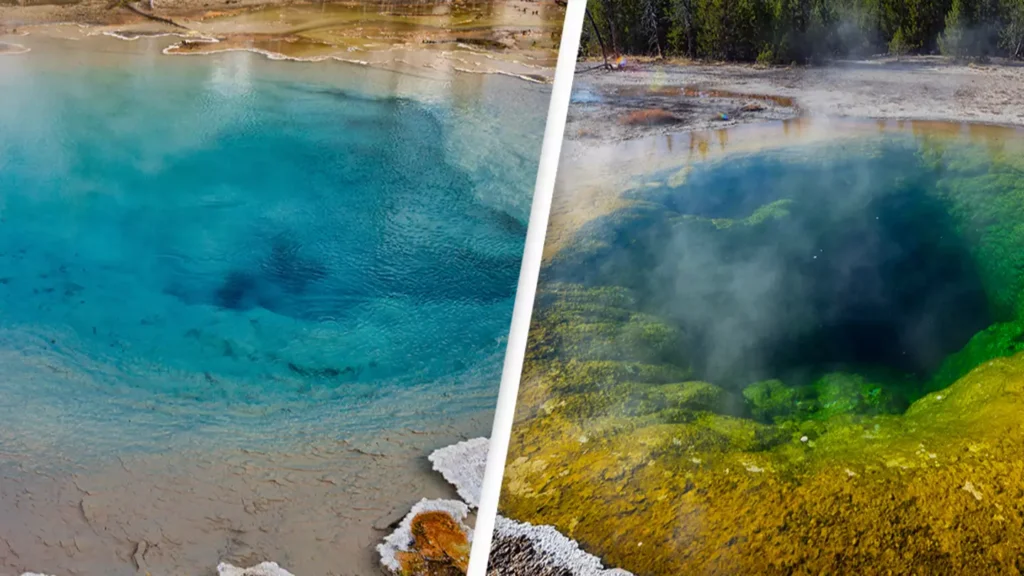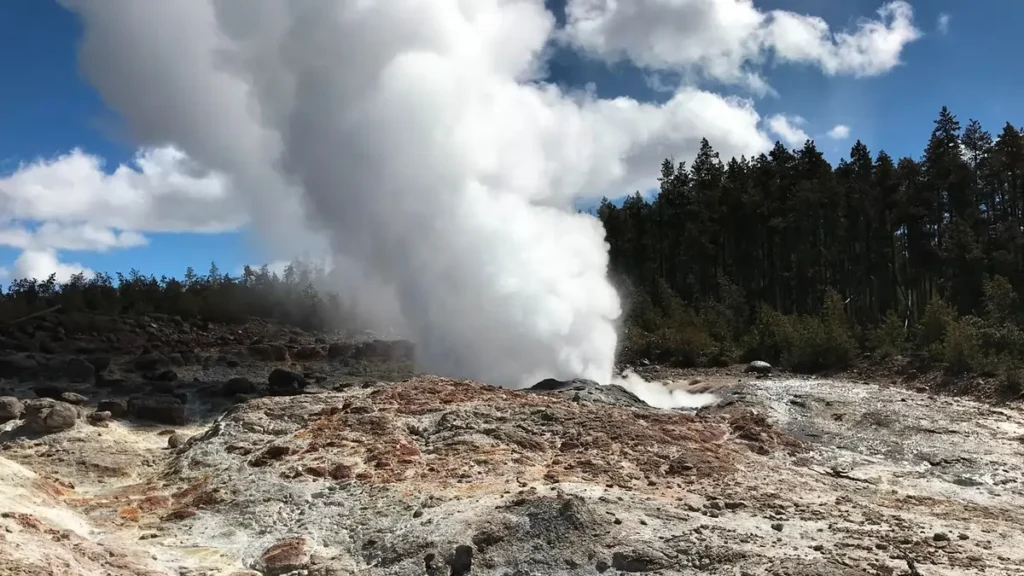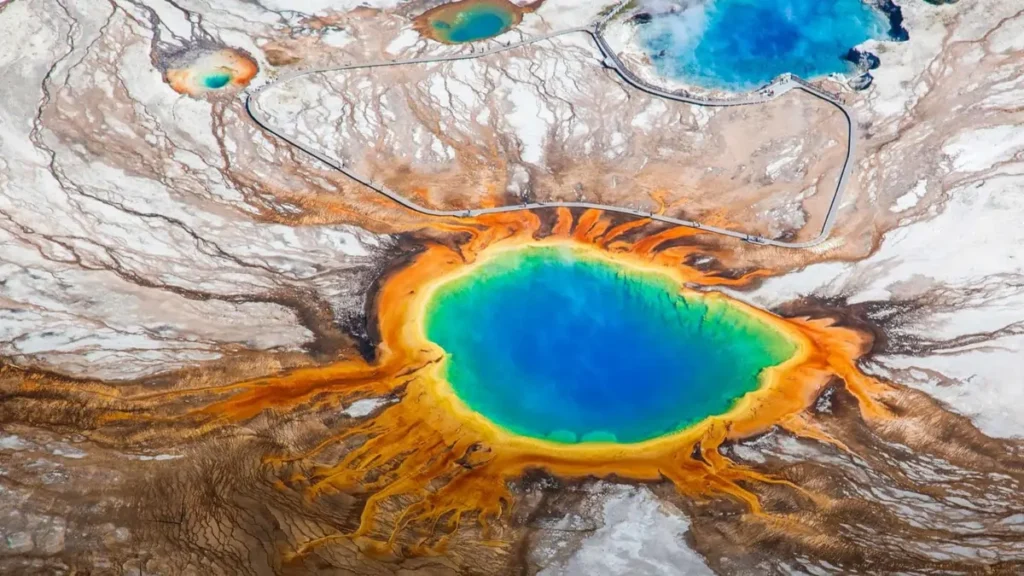Introductory
Have you ever tossed a coin into a fountain for good luck? While that may seem harmless in an urban setting, doing the same in the thermal pools at Yellowstone National Park can have devastating consequences. Millions of tourists visit Yellowstone yearly to witness its stunning geothermal features, including the famous thermal pools. Unfortunately, many unknowingly cause harm by tossing coins into these delicate ecosystems.
But why is this seemingly innocent act so harmful? In this article, we’ll explore how throwing coins into Yellowstone’s thermal pools poses a serious threat to their unique ecosystems and why it’s essential for visitors to stop this damaging behavior.
Read also: Yellowstone National Park: 5 Must-See Geothermal Wonders in Yellowstone National Park
Understanding Yellowstone’s Thermal Pools
Overview: Yellowstone National Park is home to some of the world’s most breathtaking thermal pools, fed by the park’s underground geothermal system. The vivid colors of these pools, like the famous Grand Prismatic Spring, are due to the presence of thermophilic (heat-loving) bacteria and minerals.
- Key Fact: Yellowstone contains over 10,000 thermal features, including hot springs, geysers, and fumaroles.
- Fun Fact: The vibrant colors of these pools, from orange to deep blue, are created by different bacterial communities that thrive in specific temperature ranges.
Why They Matter: Thermal pools are not just beautiful; they are sensitive ecosystems where slight changes in water chemistry can profoundly affect delicate microbial life.
Read also: 5 Geothermal Wonders Around the World You Need to See
Why Tourists Throw Coins into Thermal Pools
Overview: Tossing coins into bodies of water is a common tradition in many cultures, often linked to making wishes or bringing good fortune. Unfortunately, this practice has extended to natural wonders like Yellowstone’s thermal pools.
- Key Fact: Tourists throw coins into the pools without realizing the potential damage they cause, treating the pools as they would a public fountain.
- Cultural Insight: In ancient Rome, people tossed coins into Trevi Fountain for luck, a tradition that continues in many public water features today.
Read also: The Science Behind Geyser Eruptions: Why Nature’s Fountains Explode
Why It’s a Problem: Yellowstone’s thermal pools are living ecosystems, unlike fountains. Foreign objects like coins can severely disrupt these environments, causing long-term harm.

The Impact of Coins on the Thermal Pools
Overview: The geothermal features of Yellowstone National Park, such as its thermal pools, are marvels of nature, attracting millions of tourists annually. However, with such popularity comes the downside of irresponsible tourism. The tradition of tossing coins into these pools, perhaps viewed as an innocent gesture for good luck, carries severe consequences.
Let’s dive into how this practice threatens the park’s thermal pools. Coins, usually made from metals such as copper, nickel, and zinc, can have a serious impact when they come into contact with the unique waters of Yellowstone’s thermal pools.
1. Chemical Disruption of Water Composition
- Key Fact: The thermal pools of Yellowstone are known for their precise chemical balance, which contributes to their stunning colors and unique ecosystems. Throwing coins into thermal pools introduces foreign materials into the natural water system.
- Scientific Insight: These coins are typically made of metals like zinc, nickel, and copper, which react with the water’s unique mineral composition.
Why It’s a Threat: When metals dissolve or corrode in hot water, they release toxins that disrupt the water’s chemical composition. This change can alter the natural pH levels and affect the thermal pool’s vibrant colors, making them dull over time.
Coins also affect the pools’ heat-conductive nature. The presence of metals can disturb how heat is distributed within the pool, potentially impacting its geologic activity.
Read also: 5 Extreme Causes of Water Pollution and its Hazardous Effects
2. Damage to Bacterial Mats and Microorganisms of the Thermal Pools
- Key Fact: Metals from the coins can leach into the water, altering its chemical composition and affecting the thermophilic bacteria that thrive in these extreme environments.
- Scientific Insight: These bacteria are responsible for the brilliant colors of the thermal pools, such as the blue hues in Sapphire Pool or the yellow-orange bands in Grand Prismatic Spring.
Read also: Ecosystem | Definition, Components, and 5 Important Types of Ecosystem
Why It’s a Threat: Introducing foreign metals disrupts the natural balance of the water chemistry, which can kill the bacteria that give these pools their distinctive colors. Over time, this could lead to losing the vibrant hues that make these pools famous.
Read also: How Does Pollution Affect Animals? – 5 Tragic Effects
3. Blockage of Geothermal Vents
Overview: Another danger of tourists throwing coins into Yellowstone’s thermal pools is the potential to block geothermal vents. The geysers and thermal pools in Yellowstone are powered by underground geothermal activity. The water in these pools is heated by subterranean lava, and the vents that feed the pools act as pressure release systems.
These vents allow the superheated water to flow, and any obstruction can alter the pool’s temperature and behavior. Coins and other debris thrown into the pools often sink to the bottom and accumulate over time, leading to blockages of these essential vents.
Read also: Unlocking the Truth: Is Geothermal Energy the Ultimate Renewable Resource?

- Key Fact: Geothermal vents are crucial for maintaining Yellowstone’s thermal features’ high temperatures and unique conditions.
- Example: The Morning Glory Pool, once a brilliant blue, has faded to a greenish-yellow due to coins and other debris obstructing its vents.
Why It’s a Threat: This accumulation can significantly disturb the geothermal processes that drive the activity of thermal pools. Blocked vents may lead to reduced geyser activity, changes in water temperature, or even the complete shutdown of a pool’s thermal circulation. This may allow harmful algae to grow or lead to the death of thermophilic bacteria.
Yellowstone’s unique hydrothermal features make the park a global icon, and disrupting these systems seriously threatens its natural wonders.
Read also: Why is water pollution an emerging Global Crisis?
4. The Long-Term Effects of Foreign Objects
Overview: Unlike natural rocks or organic material, coins do not easily degrade. As a result, they remain in the thermal pools for years, continuing to leach harmful metals and potentially causing damage for decades.
- Key Fact: Yellowstone’s rangers have recovered thousands of coins and other debris from thermal pools, but some damage is irreversible.
- Scientific Fact: Coins can accumulate in the pools over time, leading to changes in the water’s clarity and color due to chemical reactions between the metals and the pool’s minerals.
Why It’s a Threat: The cumulative effects of these pollutants can spread far beyond the thermal pools themselves. The long-term presence of foreign objects can permanently alter water chemistry and destroy the thermal pools’ iconic colors and natural beauty.
Read also: CHEMICAL WEATHERING: Nature’s Incredible Power to Transform Landscapes
Wildlife, such as birds and small mammals, may come into contact with contaminated water, leading to potential health risks and poisoning. This water contamination can also extend to nearby bodies of water, affecting plant life, soil quality, and other vital natural resources within the park.
5. Loss of Aesthetic Beauty and Tourist Appeal
Overview: One of the main draws of Yellowstone National Park is the stunning visual appeal of its thermal pools. The crystal-clear water, vivid colors, and bubbling activity awe visitors.
- Key Fact: When coins accumulate in these pools, they degrade their aesthetic beauty.
- Scientific Fact: Over time, the visible buildup of coins on the bottom of the pools can tarnish the view, making these natural wonders appear dirty or unmaintained.
Read also: Environmental Pollution | 7 Types of Pollution and their Alarming Effects
Why It’s a Threat: The long-term visual impact could even affect tourism, as visitors may become disappointed in the diminished beauty of the pools. Yellowstone’s tourism economy thrives on the park’s natural wonders, and a decrease in visual appeal could lead to fewer visitors over time, harming the local economy.

| Threat | Cause | Impact |
| Chemical Disruption of Water Composition | Metals corrode from coins | Alters pH levels, disrupts natural balance, and dulls pool colors. |
| Damage to Bacterial Mats | Metals leaching from coins | Destroys thermophilic microorganisms, affecting color and filtration. |
| Blockage of Geothermal Vents | Coins settling in vents | Blocks essential geothermal vents, disrupting pool activity. |
| Long-Term Effects of Foreign Objects | Non-degrading metals in pools | Contaminates the water with metals, harming surrounding ecosystems. |
| Loss of Aesthetic Beauty and Tourist Appeal | Coins accumulation | Degrades the visual appeal, potentially affecting tourism and local economy. |
How We Can Help Protect Yellowstone’s Thermal Pools
Given these alarming threats to thermal pools at Yellowstone National Park, it’s clear that immediate action is needed to prevent further damage. As visitors, we play a crucial role in protecting these delicate ecosystems. Here are a few ways we can help safeguard Yellowstone’s thermal pools from the harmful effects of coin-throwing:
Read also: Volcanoes – The Science And Secrets Of The Mountains Of Fire
1. Enhanced Visitor Education Programs
Implement park-wide education campaigns to inform visitors about the harmful effects of throwing coins into thermal pools. Interactive exhibits and information boards at key park entrances and thermal pool viewing areas can emphasize the importance of preservation.
2. Stricter Enforcement of Park Regulations
Strengthen enforcement measures for anyone caught throwing coins into thermal pools. Increased park ranger patrols and visible fines or penalties can deter irresponsible behavior.
3. Install Clear and Prominent Signage
Place large, eye-catching signs near the thermal pools that clearly state the dangers of throwing foreign objects into the water. Visual cues like infographics can help communicate the message effectively to tourists from different backgrounds.
4. Encourage Responsible Tourism
Partner with tour companies, travel influencers, and eco-friendly organizations to promote responsible tourism practices. Encouraging visitors to follow environmental guidelines through social media campaigns or informational brochures can spread awareness.
Read also: Explosive Threat: Top 10 Most Dangerous Volcanoes on Earth
5. Create Donation Alternatives
Offer “Good Luck” donation stations at park entrances, visitor centers, or thermal pool areas. Visitors can throw coins into designated bins instead of thermal pools, and the funds will go toward Yellowstone conservation efforts.
6. Barrier Reinforcement Around Sensitive Areas
Install additional barriers or increase the height of existing ones around thermal pools to prevent tourists from physically accessing the edges of the pools, reducing the temptation or ability to throw coins.
By acknowledging these threats and mitigating the damage, we can help maintain Yellowstone National Park’s natural beauty, ensuring its continued wonder for millions of visitors in the years to come.
Read also: Biodiversity Crisis: 5 Shocking Ways We’re Losing Nature’s Riches
Conclusion
Yellowstone National Park is a national treasure, and its thermal pools are some of Earth’s most fascinating geological features. However, the threats to thermal pools at Yellowstone National Park from tourists throwing coins are serious and require immediate attention. It is essential that we, as responsible visitors, do our part to protect these natural wonders by understanding the potential damage and taking the necessary steps to prevent it.
Every action we take has a ripple effect on the environment around us. By acting responsibly, we help ensure that these unique geothermal features continue to thrive for generations. Let’s work together to preserve the beauty and integrity of Yellowstone’s thermal pools—our planet’s fragile wonders deserve nothing less.
Remember: the next time we feel the urge to toss a coin for good luck, it’s not worth the long-term cost of these irreplaceable natural gems.
Key Takeaways
- Coin tossing can cause chemical disruption, damage to microorganisms, and clogging of vents, just to name a few of the alarming threats.
- Visitors should follow park rules, spread awareness, and lead by example to protect these delicate ecosystems.
- Together, we can preserve the beauty of Yellowstone’s thermal pools for future generations.
FAQs:
1. Why is throwing coins into Yellowstone’s thermal pools harmful?
Coins introduce metals like copper and zinc into the water, disrupting the delicate ecosystems and killing the bacteria that give the pools unique colors.
2. What happens to the coins thrown into the pools?
Coins can block geothermal vents, change the water’s chemical composition, and cause long-term damage to the pool’s ecosystem.
3. Can the damage caused by coins be reversed?
In some cases, rangers can remove coins, but the chemical changes and microbial loss are often irreversible, especially if the damage has occurred over time.
4. How can I help protect Yellowstone’s thermal pools?
Stay on designated boardwalks, never throw objects into the pools, and educate others about preserving these fragile environments.
5. Are there signs in Yellowstone warning tourists not to throw coins into the pools?
Yellowstone National Park has clear signage around thermal features warning visitors of the potential damage caused by foreign objects.





